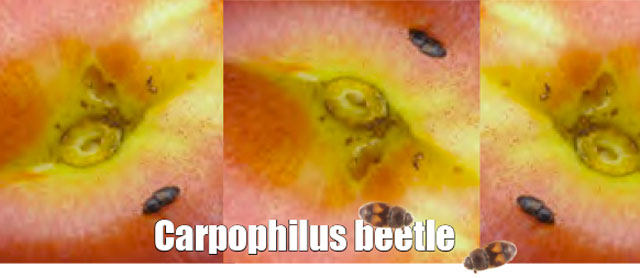Carpophilus can cause significant damage to fruit, both on the tree and postharvest, especially when temperatures exceed 20C after wet weather and when the fruit is ripening.
Pest identification
Carpophilus beetles are small (2–3 mm long) and black or brown. Their wing covers are short and they have clubbed antennae.
The larvae are yellowish, about 5 mm long when fully grown and have a brown head and forked tail.
Damage
Most commercial damage occurs to ripening stone fruit, which can be damaged on the tree as beetles burrow into the fruit, particularly near the stem end suture line.
In other fruits such as apples, only fallen fruit is damaged and the pest is not considered economically important. Adults lay eggs in rotting and damaged fruit on the orchard floor.
Mature larvae emerge from the fruit and pupate in the ground. Adults overwinter on the tree under bark or in mummified fruit.
The adult can fly several kilometres in search of hosts. Summer rains and rotting fruit are ideal conditions for breeding.
Carpophilus adults are a major vector of brown rot.
Monitoring
Using pheromone traps early in the season will give warning of Carpophilus arrival or emergence, helping with early control and management.
Weekly fruit inspections leading up to harvest may help identify the start of fruit infestation.
Management
Cultural and physical
The most important management strategy for Carpophilus is good orchard hygiene, which is improved by removing and destroying waste fruit from orchards.
Controlling Queensland fruit fly will decrease the amount of fallen fruit and reduce the potential for infestation.
A combination of weekly monitoring and/or mass trapping between stone hardening and harvest, orchard hygiene and good fruit fly control will give the best result. Traps are available from rural retailers.
Biological
An attract-and-kill system using synthetic aggregation pheromone plus food-attractant provides effective protection of ripening crops when deployed at least four weeks before harvest.
Continuing to mass-trap through harvest and for an additional two weeks after harvest will help reduce the resident pest population.
Placing traps upwind on the outside edges of the orchard will ensure maximum pheromone spread.
Download the Orchard plant protection guide 2020-21
See this article in Tree Fruit February 2021




















